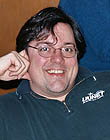|
|
 
|
|
Author
|
Topic: Speed control
|
|
|
|
|
|
|
|
|
|
|
|
|
Gary Jarvis
Film Handler
Posts: 6
From: NY, NY, USA
Registered: Aug 2009
|
 posted 08-25-2010 09:11 AM
posted 08-25-2010 09:11 AM




Sorry for the double threading!
At the moment I am interweaving manually, saving as a QT then saving as sequences, at which point I am importing the sequences into Premiere pro as non speed defined frames. My next task is to create a speed.
I am in the event/concert industry, one of the companies I work with has a bunch of Christie "M" series, I understand they have 3 dlp chips but have know idea of what they can do, yet.
I have seen some of the 3d units out there but, are they real 120 p fps I have seen some of the video clips and they are with left and right eye pics in the same frame, one above the other and state 120 fps only, I think that is 60 fps per eye where they show the double image/frame frame as interlaced, then by wearing the glasses each eye see's a different field. I may be wrong and if so please correct me..
"DLP based DCI-3D projectors can display 'real' 144Hz - but only internally tripled from 48Hz sources, not input-to-output.
" First is it real 144hz i.e. 144 p fps. how do they triple internally? who manufactures the projectors?
Hey Carsten David thanks for the progressive response
GAry
| IP: Logged
|
|
Carsten Kurz
Film God
Posts: 4340
From: Cologne, NRW, Germany
Registered: Aug 2009
|
 posted 08-28-2010 05:43 AM
posted 08-28-2010 05:43 AM




Alright, so you are into 3D/stereo?
- most consumer grade beamers will only accept or display 'real' 60Hz. You can do time-sequential 3D with them, but only with a very annoying 30Hz stereo rate.
- the mentioned 3D-Ready beamers will accept 120Hz, thus can do 60Hz L/R flip rate
- DCI-Projectors, that is, real D-Cinema projectors, typically will accept up to 60Hz from 3D enabled servers or graphics cards. They have a choice of different 3D configuration options. E.g. in a standard cinema 3D setup, they will accept a 48Hz input L/R sequence and produce a 144Hz LR-LR-LR stereo sequence to minimize L/R flicker. But these projectors won't accept 144Hz signals at the input, it's only tripled internally.
- the same machines, to my knowledge, will accept a 60Hz input from a computer and, instead of 144Hz triple flash, can be setup to do 120Hz doubleflash. To my knowledge, with current DLP technology, 180Hz tripleflash is not possible, hence the doubleflash.
These systems cost 40.000 to 70.000 Euro in a typical D-Cinema context. You might want to contact the manufacturers (Christie, Barco, NEC) to check wether their professional non-DCI 'beamers' (like Christie M-Series) might have similiar options. But these machines will still cost 15.000-40.000 Euro I guess, while 3D-Ready consumer grade beamers go from 600 Euro. As both will do 120Hz stereo rate, a cheap 3D-Ready beamer might be nice for production and previewing, while a 120Hz enabled professional machine could be used for presentation.
That would also allow a hassle-free NTSC/30Hz/60Hz/120Hz compatible editing work flow, since most editing will be done on 60Hz computer displays, at least in your area I guess (Guys, I DO know that NTSC is 29,97 ;-)
All I said is for viewing with shutter glases, that is, glases that will cover every other frame in a L/R sequence. There are other systems as well, polarizing glases, or Infitec filters. Depends on production and viewing conditions wether they could be a better option. Shutter systems currently are easier to get and setup - basically, you buy a 3D-Ready beamer and shutter glases for <1000US$ and off you go. Polarizing glases will probably be better for larger audiences, because they are a lot cheaper (disposable). But a ploarizing setup is more complicated and needs a dedicated metalized ('silver') screen. However, you can get away with 30/60Hz signals in some situations, since a parallel polarizing projetion setup does not need to do double/triple flashing.
Note that 3D signal storage/transmission and 3D display might be different - you can transfer a 24fps stereosequence either sequentially as a 48fps L-R signal, or, as common in the upcoming homecinema 3D systems, as a 24fps side-by-side or over-under 'BigFrame' format. However, the display or projector then decides how to deal with these signals depending on it's 3D display technology.
Typical consumer 3D-LCDs or plasma screens e.g. will accept a side-by-side base rate signal and create a double-rate image display from them.
So, there is no straight relation between 3D signal composition and 3D display technology. The mentioned 3D ready beamers will only accept a direct 120Hz sequence, no 'BigFrames' or side-by-side. This will probably change soon.
Oh well, there's more to say, but I'll stop for now ;-)
- Carsten
| IP: Logged
|
|
|
|
|
|
All times are Central (GMT -6:00)
|
|
Powered by Infopop Corporation
UBB.classicTM
6.3.1.2
The Film-Tech Forums are designed for various members related to the cinema industry to express their opinions, viewpoints and testimonials on various products, services and events based upon speculation, personal knowledge and factual information through use, therefore all views represented here allow no liability upon the publishers of this web site and the owners of said views assume no liability for any ill will resulting from these postings. The posts made here are for educational as well as entertainment purposes and as such anyone viewing this portion of the website must accept these views as statements of the author of that opinion
and agrees to release the authors from any and all liability.
|

 Home
Home
 Products
Products
 Store
Store
 Forum
Forum
 Warehouse
Warehouse
 Contact Us
Contact Us




 Printer-friendly view of this topic
Printer-friendly view of this topic







![[dlp]](graemlins/dlp.gif) is very much a part of it.
is very much a part of it.



